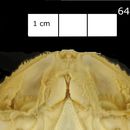en
names in breadcrumbs


Defense mechanism: "Calappa, when seized, often draws up its legs under the broad shields formed by the overlapping edges of the carapace, thus seeming to sham death. No doubt it is more difficult to dismember in this attitude, but it is quite possible that the action has no such special significance in this case, being instinctively adopted whenever the animal is moved against its will. The colouring of many Calappidae is another feature in which they are adapted to their environment, being sand-like, and clearly protective."
Calappa are usually more active than other sand crabs. (Borradaile, 1903)
One specimen "taken at Hulule, Male Atoll and in Minikoi lagoon down to 5 fathoms." (Borradaile, 1903)
Inhabit sandy areas. (Borradaile, 1903)
Respiration: From their concealment in the sand, they create breathing channels to the surface of the sand. "The Calappidae draw in water, like many other crabs, down a passage formed, so to speak, by 'holding the hands against the breast,' and so into the gill-chamber through an opening in front of the chelipeds, guarded by the wide base of the epipodites of the third pair of maxillipeds. But their hands (chelae) are peculiarly shaped for this purpose, being very broad and flat, and usually having a toothed crest, which is held against the forepart of the body. Through the notches between the teeth water can enter, while at least the coarser sand-grains are kept out." (Borradaile, 1903)
Basic mode of nutrient uptake is heterotrophy.
"Judging from the contents of their stomachs, de Haan came to the conclusion that Calappa... feed on other crabs." (Borradaile, 1903)
Calappa hepatica, the reef box crab,[2] is a common benthic species of box crab of tropical and subtropical parts of the Indian and Pacific Oceans and the Red Sea.[3]
Calappa hepatica grows to a carapace width of about 4 cm (1.6 in); the length is always less than two thirds of its width. The posterior portion of the shell has broad extensions with several blunt teeth on the margin, and these largely conceal the walking legs. The carapace and the exposed parts of the chelae (pincers) are a mottled greyish-brown colour, and are covered with small raised tubercles of various sizes, making the crabs well-camouflaged when semi-submerged in the sand. The chelae are large and powerful, and specially adapted to the crab's feeding behaviour, the crushing and eating of molluscs.[2][4]
Calappa hepatica is found in the tropical and subtropical Indo-Pacific region, its range extending from the Red Sea to Hawaii, French Polynesia, Cocos Island and northern Australia. Its typical habitat is on the sandy or shelly sand seabed, often in reef habitats, and seagrass meadows, at depths down to about 150 m (500 ft).[5]
During the day, Calappa hepatica remains buried in sand with only the area round the eyes protruding. It emerges at night to hunt for prey, and can rebury itself in the substrate efficiently and fast if danger threatens.[6] It is a predator, and largely feeds on bivalve and gastropod molluscs, as well as hermit crabs. It has a specially adapted right chela which it uses to break open the shell of its prey; for this purpose it has a large accessory tooth located at the base of the hinged part of the claw, which is located opposite a flat plate on the fixed part, the two working together like a vice.[7] After breaking open the shell, it uses its left pincer, which is longer and more pointed than the right, to pick out the soft tissues.[7]
Calappa hepatica, the reef box crab, is a common benthic species of box crab of tropical and subtropical parts of the Indian and Pacific Oceans and the Red Sea.